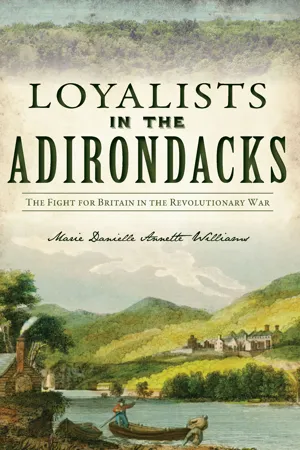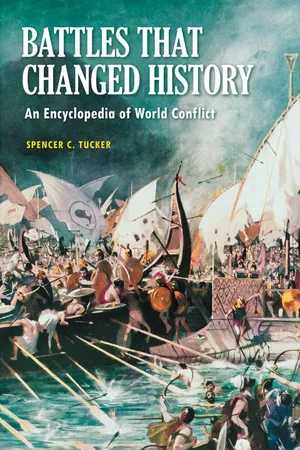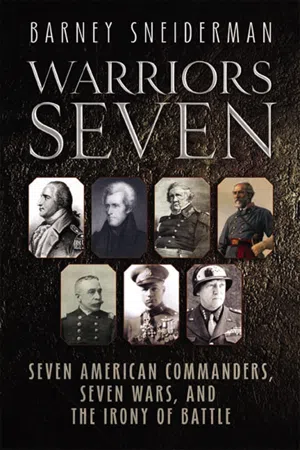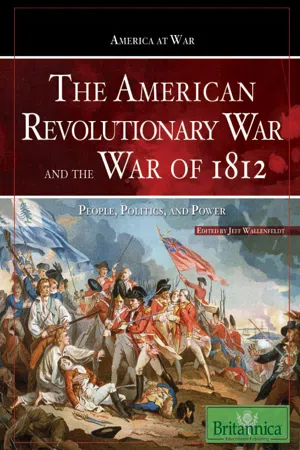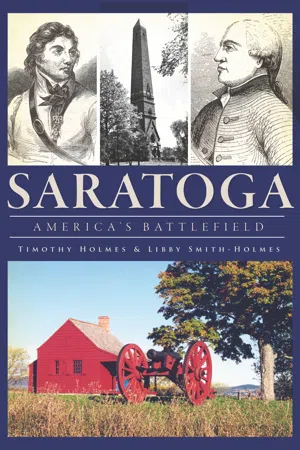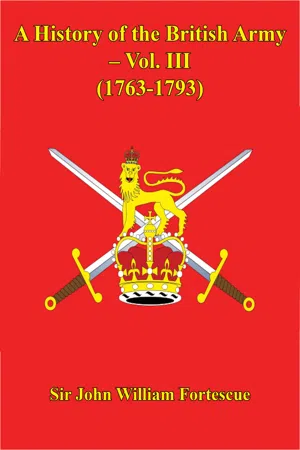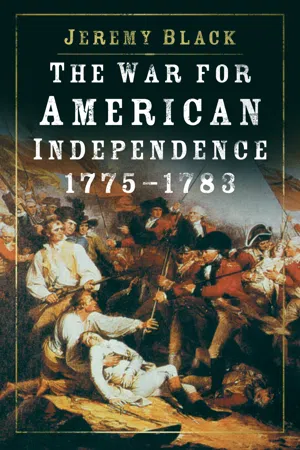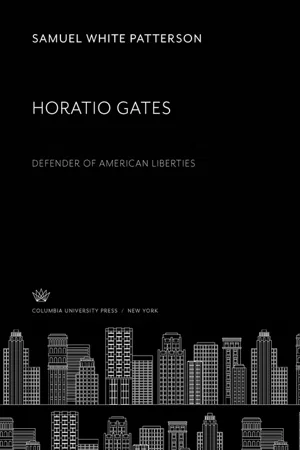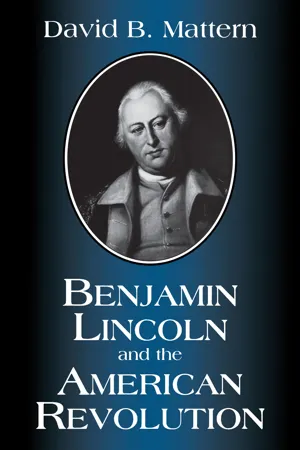History
Battle of Saratoga
The Battle of Saratoga, fought in 1777 during the American Revolutionary War, was a turning point for the American forces. The American victory at Saratoga is considered a major triumph, as it led to France formally entering the war on the side of the Americans. This support from France significantly strengthened the American cause and helped secure their eventual victory.
Written by Perlego with AI-assistance
Related key terms
1 of 5
12 Key excerpts on "Battle of Saratoga"
- eBook - ePub
Loyalists in the Adirondacks
The Fight for Britain in the Revolutionary War
- Marie Danielle Annette Williams(Author)
- 2023(Publication Date)
- The History Press(Publisher)
The Battle of Saratoga, and the Saratoga Campaign as a whole, was a turning point in the Revolution. The success of the American forces at these battles drove the British forces from fighting the Americans in New York for a time and showed the world that the Americans, although not educated in the ways of war to the extent the British military was, could hold their own and be successful. From the victory at the Battle of Saratoga came agreements between the French and the Americans and the Dutch and the Americans. Those European nations pledged to provide the fledgling army with men, ships and money to fight the remainder of the war, and this turned the tide in the Americans’ favor.With their failure to take New York and split the colonies in half as intended, the British left New York for a time and focused their energy on battles elsewhere.The famous boot monument of Saratoga National Battlefield Park.THE VICTORY AT THE - eBook - PDF
Battles that Changed History
An Encyclopedia of World Conflict
- Spencer C. Tucker(Author)
- 2010(Publication Date)
- ABC-CLIO(Publisher)
Parsippany, NJ: Silver Burdett, 1984. Ward, Christopher. The War of the Revolution, Vol. 1. New York: Macmillan, 1952. Battles of Saratoga Date September 19, October 7, 1777 Location Saratoga in upper New York State (eastern United States) Opponents (* winner) *Americans British Commander Major General Horatio Gates Lieutenant General John Burgoyne Approx. # Troops 6,000 (1 st ), 11,500 (2 nd ) 7,000 (1 st ), 6,617 (2 nd ) Importance The surrender of an entire British army convinces France to enter the war openly on the American side, making the American Revolutionary War a worldwide conflict 246 | Battles of Saratoga Two battles fought at Saratoga, New York, in September and October 1777 marked a turning point in the American Revolutionary War (1775–1783). The Saratoga Campaign originated with British major general John Burgoyne. He had returned to England early in 1777 and presented to King George III and Secretary of State for the Colonies Lord George Germain a plan to split off New England, the font of the rebellion, from the remainder of the colonies and thus snuff out the revolt. Bur- goyne envisioned a three-pronged campaign. The major thrust would drive from Canada down the Lake Champlain–Hudson Valley corridor, while a secondary ef- fort pushed eastward from Lake Erie up the Mohawk Valley. The two forces were to meet at Albany and join the third prong, a British drive up the Hudson from New York City. There were two principal problems with Burgoyne’s plan. First, it took little ac- count of logistics, and second, it depended heavily on simultaneous execution. It was further hampered by the fact that while he was approving Burgoyne’s plan, Germain also approved a different plan submitted by Major General William Howe. Howe proposed to move south from New York against Philadelphia. - eBook - ePub
Warriors Seven
Seven American Commanders, Seven Wars, and the Irony of Battle
- Barney Sneiderman(Author)
- 2006(Publication Date)
- Savas Beatie(Publisher)
The immediate effect of Burgoyne’s defeat was the evacuation of Crown Point and Ticonderoga and the withdrawal of their garrisons to Canada. The war had four years to run but never again did the British mount an serious offensive in the north. The long- term impact was of sufficient magnitude for historians to rank the fighting at Saratoga as one of the most decisive battles in military history. When news of the defeat reached London, it kindled fears that Britain’s arch enemy France would enter the war. The French had been secretly supplying the Americans with arms, but had thus far refrained from formal recognition of American independence, notwithstanding the persistent lobbying of Benjamin Franklin and others.That all changed with Saratoga. Twenty-four hours after learning of Burgoyne’s surrender, the French government granted formal diplomatic recognition to the United States. The following February, France signed a treaty of alliance with the Americans and a month later declared war on England. Aside from the material aid rendered to the Americans, the French army and navy played crucial roles in the fighting ahead. Saratoga was not only the turning point of the Revolutionary War, but also played a small but contributing role in one of history’s most cataclysmic events: the French Revolution. One immediate effect of the Revolution was its bankrupting of France. The money expended on the alliance with the fledgling United States helped empty the French treasury.And what of Arnold and his left leg? The Hessian’s bullet had shattered his left femur. When his doctor told him that it must be amputated, Arnold adamantly refused. After days of excruciating pain his condition improved, but it was not until January that he could sit up in bed. A month later he left the hospital in Albany on crutches. He would walk with a limp for the rest of his life, his left leg shorter than the right.Twice, once at Quebec and again at Saratoga, Arnold refused to have his leg amputated. Whatever his reasons, given the high mortality rate of amputees it was not folly to refuse the amputation of a limb. Amputation in Arnold’s time was a ghastly business. There was no anaesthetic (except whisky, if available), and there was no understanding of sepsis (disease caused by bacterial infection), which meant surgeons used dirty hands to operate with dirty surgical instruments. If they were fortunate, patients were administered opium for post-surgical pain. It is a testimony to the resiliency of the human body that anyone survived such an ordeal. For example, Admiral Horatio Nelson of Trafalgar fame had an arm amputated in 1797 when wounded by a musket ball, but quickly recovered. By the time of the Civil War, both chloroform pre-op and morphine post-op helped patients overcome the trying surgery. Since the germ theory of disease did not enter the medical mainstream until the late 1800s, the surgeon’s hands and instruments remained germ-ridden, triggering a high mortality rate from what today would be considered non-mortal wounds. - eBook - ePub
The American Revolutionary War and The War of 1812
People, Politics, and Power
- Britannica Educational Publishing, Jeff Wallenfeldt(Authors)
- 2009(Publication Date)
- Britannica Educational Publishing(Publisher)
George Washington standing with the flags captured from the British in the Battle of Trenton . Library of Congress Prints and Photographs DivisionThe effect of these early American victories in the battles of Trenton and Princeton, the first successes won by Washington in the open field, was marked. Following close upon a series of defeats, they put new life into the American cause and renewed confidence in Washington as commander of the Revolutionary Army.BATTLES OF SARATOGA
The closely related engagements in the fall of 1777 known as the Battles of Saratoga are often characterized as the turning point of the war in favour of the Americans. The failure of the American invasion of Canada in 1775–76 had left a large surplus of British troops along the St. Lawrence River. In 1777 these troops were to move south and join forces with Gen. Sir William Howe’s troops along the Hudson River.Leading a force of about 8,000 British troops southward, Gen. John Burgoyne forced the surrender of Fort Ticonderoga (July 6) and Fort Edward on the upper Hudson (July 31). He left nearly 1,000 men behind to garrison Fort Ticonderoga. Having collected 30 days’ rations, Burgoyne crossed the Hudson and encamped near Saratoga, N.Y. Gen. Horatio Gates, the American commander, was camped four miles away with 12,000 men and was receiving daily reinforcements.On September 19 Burgoyne’s army moved south and engaged the Continental forces at the Battle of Freeman’s Farm, or the First Battle of Saratoga. Burgoyne failed to pierce Gates’s lines, however, and thus open a way to Albany. On October 7 he led 1,500 of his men out on reconnaissance but met with a fierce American counterattack under Gen. Benedict Arnold. This engagement was called the Battle of Bemis Heights, also known as the Second Battle of Freeman’s Farm or the Second Battle of Saratoga. By now Burgoyne’s army had been reduced to about 5,000 effective troops, and his supplies were running low. On October 8 Burgoyne began his retreat, but Gates, who had 20,000 men by now, surrounded him at Saratoga. On October 17 Burgoyne surrendered his troops under the Convention of Saratoga, which provided for the return of his men to Great Britain on condition that they would not serve again in North America during the war. - eBook - ePub
George Washington's Westchester Gamble
The Encampment on the Hudson & the Trapping of Cornwallis
- Richard Borkow(Author)
- 2021(Publication Date)
- The History Press(Publisher)
The British disaster at Saratoga would soon lead to a Franco-American military alliance and would force the war office in London to alter its American strategy. Nevertheless, the king and his war ministry remained adamant. However great the setback at Saratoga, the American rebellion could still be—and must be—suppressed. If the American colonies were lost, the prestige of the British Empire would suffer an intolerable blow. 47 Thus, the American success at Saratoga, impressive as it may have been, was not sufficient by itself to bring victory in the war. The next four years showed that French military strength, by itself, was also not enough. In order to be effective, French armed force would have to be utilized astutely. During the forty-month period that followed the Franco-American alliance and preceded the Lower Westchester Encampment, Washington repeatedly tried to strike decisive blows against the enemy with the help of French military power. None of the attempts was successful. The victory at Saratoga had a greater impact on morale at home and on the reputation of the American army abroad than all of the American defeats of 1777. Not only morale and reputation were affected. An open American-French alliance was a direct result of Saratoga, and a treaty was signed in February 1778. The mere announcement of the treaty brought immediate benefit to the United States, for the British were compelled to divert some of their forces from the United States to protect their sugar islands in the West Indies. During a time of war, those immensely profitable islands would be at risk of French attack. Congress was thrilled with the Franco-American treaty. It was not only a matter of military assistance. The Franco-American treaty represented international recognition, the first that the United States had ever received - eBook - ePub
Saratoga
America's Battlefield
- Timothy Holmes, Libby Smith-Holmes(Authors)
- 2012(Publication Date)
- The History Press(Publisher)
Chapter 2 The Battles of Saratoga, 1777THE MILITARY SITUATION TO 1777The prospects for American independence were grim as the military campaign season of 1777 approached. A string of recent defeats exposed the weaknesses of the inexperienced and undermanned Continental army in the face of the well-trained British forces and made distant the memories of American victories in 1775 at Lexington and Concord, Fort Ticonderoga and Bunker Hill. In the Northern Department, under the command of General Philip Schuyler, an ill-conceived operation against Canada aimed at driving the British out and drawing French Canadians to the cause resulted in defeat at Quebec City in December 1775.As the tattered remnants of the American forces led by Benedict Arnold attempted to lay siege to the city, some four thousand troops under the command of General John Burgoyne reinforced Sir Guy Carleton, governor and commanding general of the British forces in Canada. Carleton mounted a counteroffensive in June 1776 that drove the Americans out of Canada and into the southern end of the Champlain Valley. He then began preparations for a naval assault on the American strongholds at Crown Point and Fort Ticonderoga. Once the forts were captured, he intended to cross over to the Hudson River, capture Albany and establish communications with General William Howe’s army in New York City.Valcour Bay, the site of the 1776 battle, is now a National Historic Landmark, as is the USS Philadelphia, which sank shortly after the October 11 battle and was raised in 1935. Many American ships and small boats were sunk intentionally to keep them out of the hands of the British. In 1997, another pristine underwater wreck was located during a survey by the Lake Champlain Maritime Museum. Two years later, it was conclusively identified as the gundalow Spitfire; this site was listed on the National Register in 2008. Lossing - eBook - PDF
Where a Man Can Go
Major General William Phillips, British Royal Artillery, 1731-1781
- Robert P. Davis(Author)
- 1999(Publication Date)
- Praeger(Publisher)
Chapter 6 Saratoga If one could compare America's Revolution to its subsequent Civil War, the unintentioned contest of Saratoga may have been the Gettysburg of the Revolu- tion—the "high-water mark" of England's response to colonial rebellion. Events in the four distressful years after Saratoga were mostly anticlimactic to the rebellion's ultimate end. The coming battle, which actually occurred some distance south of the town of Saratoga along the upper reaches of the Hudson River, was more accurately "two" separate battles. They have since become identified by the locations at which they were fought, Freeman's Farm and Bemis Heights. John Burgoyne's irrevocable commitment to the final leg of his campaign was to cross his army over the Hudson River on the thirteenth and fourteenth of September 1777. His tactical master plan, to halve the northern colonies of America from Lake Champlain to Albany, New York, was quickly changing from a triumphal offensive to a cautious penetration into enemy territory. The inevitable clash between his army and the rabble force to his front was losing its original ambitious promise of success. As each day passed, the Americans were massing a more intimidating army to face down his expedition. With the whole of his army and its baggage rejoined, Burgoyne had the suf- ficient supplies he needed for the next twenty-five days. He was confident his army was strong enough to move forward, deal with the American army, and subsequently get itself to Albany. The troops were in relatively good shape, and he could not have been more pleased with the army's capable and dedicated senior line officers. They were all zealous professionals and had proven them- selves time and again throughout the campaign. On the thirteenth of September Burgoyne crossed the Hudson River just south of Fort Miller, consigning his army to its fate. Since it would take all of that day and part of the next to complete the crossing, his first regiments over - Hon. Sir John William Fortescue(Author)
- 2014(Publication Date)
- Normanby Press(Publisher)
CHAPTER XII — AMERICA – 1777-1778
Effects of the Disaster of Saratoga — Exultation of the Opposition in Parliament — Patriotic Spirit throughout the Country — Futile Endeavours of the Opposition to counteract it — Alliance of France with the revolted Colonies — Disunion of the Opposition on the American Question — Death of Chatham — Revision of former Plans against America — Continued Infatuation of Germaine — Washington at Valley Forge — Inaction and Apathy of Howe — He resigns the Command to Clinton — Clinton evacuates Philadelphia and retreats to New York — Action of Freehold — Arrival of the French Fleet under d’Estaing off the American Coast — In unsuccessful Attempt upon Rhode Island — Washington’s Difficulties with French Officers — D’Estaing sails for the West Indies.
1777
FEW events in our history have been more momentous in their results than the disaster of Saratoga. In itself it might have seemed to be nothing past repair. The loss of four thousand troops for service in America only (for such were the terms of capitulation) was not so great as to be irremediable, and the operations of the campaign had not been entirely thrown away. Ticonderoga had been recovered, and, though much material of war had been lost, infinitely more had been captured and destroyed both by Burgoyne himself and by Clinton. Nevertheless the fact remained that a British army, or the remnant of one, had been beaten and captured; whereby a great blow had been dealt at the reputation of England, and great encouragement given not only to the revolutionary party in America, but to that far more dangerous and unscrupulous enemy, the Opposition in the British Parliament.The Houses met early in November, when the country was still exulting over the capture of Ticonderoga and the victory of Brandywine; but the news of Bennington was also come, and newspapers and politicians were already croaking prophecies of disaster to Burgoyne. They spoke not from any military knowledge, for they had uttered the same sinister predictions as to every movement of British troops during the war,{253}- eBook - ePub
- Jeremy Black(Author)
- 2021(Publication Date)
- The History Press(Publisher)
7
1777: Philadelphia and Saratoga
The rebels stood their ground till our troops charged them with fixed bayonets, upon which they immediately decamped with great precipitation, and I fancy that hour would have put an end to the Yankee empire, if the darkness of the night and the fatigue of our troops had not rendered any longer pursuit impossible.Lord Lindsay on Brandywine1The hopes of the people at large, as well as of the Rebel army, are greatly raised from this event [Saratoga] … I do not apprehend a successful termination to the war from the advantages His Majesty’s troops can gain while the enemy is able to avoid, or unwilling to hazard a decisive action, which might reduce the leaders in rebellion to make an overture for peace; or, that this is to be expected, unless a respectable addition to the army is sent from Europe to act early in the ensuing year … If this measure is judged to be inexpedient, or cannot be carried into execution, the event of the war will be very doubtful.Were any one of the three principal objects viz: New York, Rhode Island or Philadelphia given up to strengthen the defence of the other two one corps to act offensively might be found, in the meantime such a cession would operate on the minds of the people strongly against His Majesty’s interests … in the apparent temper of the Americans a considerable addition to the present force will be requisite for effecting any essential change in their disposition and the re-establishment of the King’s authority.Howe to Germain, 30 November 17772BRITISH PLANS
The year 1777 was to be one in which British generals mismanaged the war, while the Americans fought with more success than the previous year. It marked arguably the last real chance the British had, if indeed one had ever existed, to conquer America. 1777 was the last year in which the British fought only the Revolutionaries and did not have to worry about French naval power. It was a year in which British forces were well-supplied. Their position was considerably better on 1 January 1777 than it had been a year earlier. Canada had been cleared and the British army based there had been able to operate as far forward as Crown Point. Boston had been evacuated successfully, New York City captured and the main American army defeated. Arguably, the principal setback had been not the failure to exploit these successes, but rather the continued inability to make any real military impact south of New Jersey and the sustained consolidation of the Revolution there. - eBook - PDF
Horatio Gates
Defender of American Liberties
- Samuel White Patterson(Author)
- 2019(Publication Date)
- Columbia University Press(Publisher)
Momentous years! Now, at fifty, he stood at the peak of his career, lauded as few have ever been. The Convention of Saratoga had made the Declaration of Independence something more than a handsome gesture of provincial statesmen. Really, General Gates had done more than could then be perceived. He had turned the tide of the American Revolution. In effect, he had made Yorktown possible. The triumph over Burgoyne changed the atmosphere of discus-sion wherever thoughtful men met. In England political and military views underwent a radical change. No mere revolt, but a revolution had been taking place. An important section of opinion was disposed to grant the King's subjects everything short of full autonomy. The prime minister himself pointed the popular trend when he presented a new scheme of conciliation to Parliament. The historian Gibbon epitomized public sentiment: Dreadful news indeed! An English army . . . laid down their arms, and surrendered, prisoners of war, on condition of being sent to Eng-land, and of never serving again against America. . . . A general cry for peace. 1 In France opinion quickly crystallized in favor of the United States. Business men took heart. Once again they seemed willing to stake their financial future on America. To capitalize this re-newed interest, Congress promptly commissioned Benjamin Frank-lin, Arthur Lee, and John Adams to negotiate a commercial and possibly a political accommodation with the court of Louis. In T H E V I C T O R OF S A R A T O G A 185 December a treaty was drafted; in February It was formally signed; in May it became generally known. O ! that was a delightful time! exulted a young French officer in Washington's army, his memory still fresh and vivid after many years. It bound me forever to the country of my adoption. 2 As early as August, 1776, Franklin had written Gates that French influence was quietly sending over arms and ammunition. - eBook - PDF
- David B. Mattern(Author)
- 2023(Publication Date)
- University of South Carolina Press(Publisher)
Somewhat later he wrote to Lincoln that "exclu- sive of the most sincere personal friendship I owe you, believe me, Sir, I 49 Benjamin Lincoln and the American Revolution regard' d your Presence in the field in the Critical Hour in which you was constrained to retire as a matter in which the Public was deeply inter- ested." When news reached Washington's army near Philadelphia the com- mander was solicitous. Timothy Pickering also "lamented the misfortune of that good man," adding, "I hope he will not lose his leg; his life and health will at a future as well as in the present period be important to our State." 19 Meanwhile, Burgoyne's army thrashed about like a rabbit in a snare under the gathering fire of the Americans. Retreating under pressure from front and flanks, Burgoyne was finally surrounded on 13 October. On that day he convened a council of war, which decided that negotiations for an "honorable capitulation" were in order. On the morning of 17 October 1777 the British laid down their arms, and the Saratoga cam- paign came to a stunning and victorious close. The importance of the battle could not be overestimated. For a body of amateur soldiers to in- duce an army of proud veterans to surrender was an astounding achieve- ment. The victory not only boosted the confidence of the American army but also won the political recognition and military support of France, in the form of a treaty of alliance signed in February 1778. 20 From his Albany hospital bed Lincoln surveyed the result with satis- faction. A congressional resolution of 4 November honored him, along with Gates and Arnold, for his part in the victory over Burgoyne. Friends such as Gen. Henry Knox wrote to congratulate him, revealing a twinge of jealousy at Lincoln's good fortune: "We at the Southward are quite put out of countenance by the brilliancy of your success." And Dr. - eBook - ePub
The Fifteen Decisive Battles of the World
From Marathon to Waterloo
- Edward Shepherd Creasy(Author)
- 2012(Publication Date)
- Dover Publications(Publisher)
XIII. VICTORY OF THE AMERICANS OVER BURGOYNE AT SARATOGA, 1777 “Westward the course of empire takes its way; The first four acts already past, A fifth shall close the drama with the day: TIME’S NOBLEST OFFSPRING IS ITS LAST.” BISHOP BERKELEY.“Even of those great conflicts, in which hundreds of thousands have been engaged and tens of thousands have fallen, none has been more fruitful of results than this surrender of thirty-five hundred fighting-men at Saratoga. It not merely changed the relations of England and the feelings of Europe towards these insurgent colonies, but it has modified, for all times to come, the connexion between every colony and every parent state.”—LORD MAHON.OF THE FOUR great powers that now principally rule the political destinies of the world, France and England are the only two whose influence can be dated back beyond the last century and a half. The third great power, Russia, was a feeble mass of barbarism before the epoch of Peter the Great; and the very existence of the fourth great power, as an independent nation, commenced within the memory of living men. By the fourth great power of the world I mean the mighty commonwealth of the western continent, which now commands the admiration of mankind. That homage is sometimes reluctantly given, and accompanied with suspicion and ill-will. But none can refuse it. All the physical essentials for national strength are undeniably to be found in the geographical position and amplitude of territory which the United States possess: in their almost inexhaustible tracts of fertile, but hitherto untouched soil; in their stately forests, in their mountain-chains and their rivers, their beds of coal, and stores of metallic wealth; in their extensive sea-board along the waters of two oceans, and in their already numerous and rapidly increasing population. And, when we examine the character of this population, no one can look on the fearless energy, the sturdy determination, the aptitude for local self-government, the versatile alacrity, and the unresting spirit of enterprise which characterise the Anglo-Americans, without feeling that he here beholds the true moral elements of progressive might.
Index pages curate the most relevant extracts from our library of academic textbooks. They’ve been created using an in-house natural language model (NLM), each adding context and meaning to key research topics.
